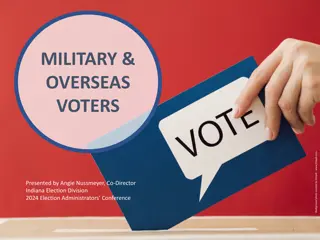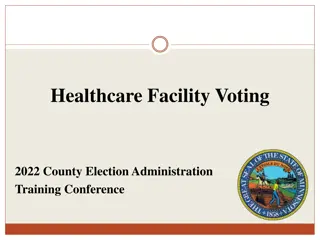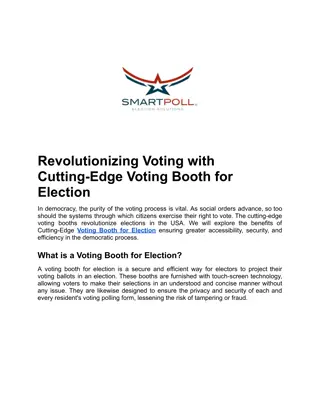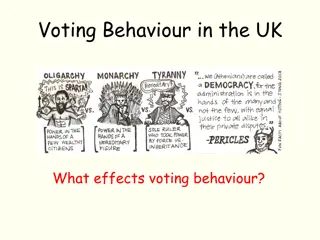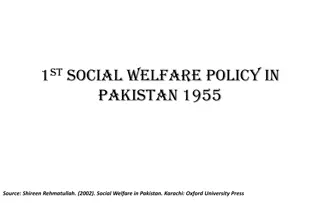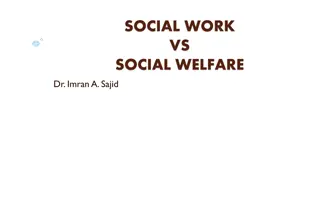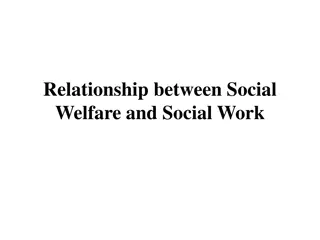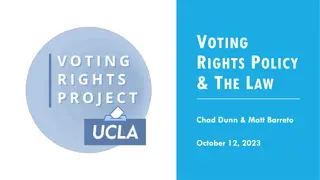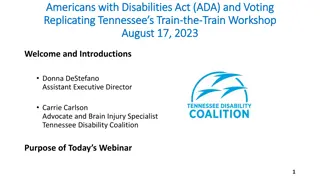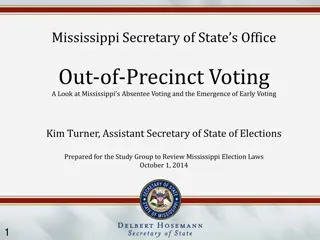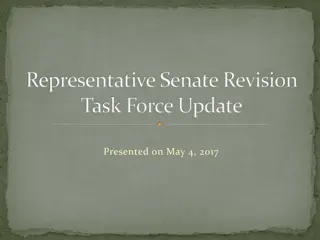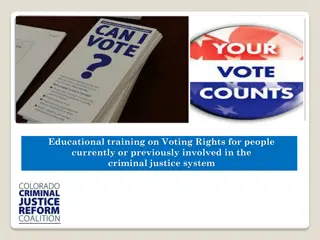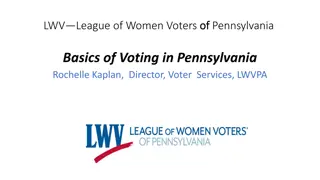Understanding Social Welfare and Voting Systems
Explore the concept of social welfare in decision-making, including Arrow's Impossibility Theorem, Gibbard-Satterthwaite Theorem, VCG mechanism, and competitive prices for positions. Learn about collective decision-making for elections, restaurant choices, and more, using various voting methods like majority voting, Borda count, and Condorcet winner. Uncover challenges like Condorcet paradox and the need for fair and effective voting systems.
Download Presentation

Please find below an Image/Link to download the presentation.
The content on the website is provided AS IS for your information and personal use only. It may not be sold, licensed, or shared on other websites without obtaining consent from the author. Download presentation by click this link. If you encounter any issues during the download, it is possible that the publisher has removed the file from their server.
E N D
Presentation Transcript
Social Welfare, Arrow + Gibbard- Satterthwaite, VCG+CPP 1
Collectively choose among outcomes Elections, Choice of Restaurant Rating of movies Who is assigned what job Goods allocation Should we build a bridge? Participants have preferences over outcomes A social choice function aggregates those preferences and picks an outcome
If there are two options and an odd number of voters Each having a clear preference between the options Natural choice: majority voting Sincere/Truthful Monotone Merging two sets where the majorities are the same preserves majority Order of queries has no significance
If we start pairing the alternatives: Order may matter Assumption: n voters give their complete ranking on set A of alternatives a10, a1, , a8 am L the set of linear orders on A (permutations). Each voter i provides i2 L Input to the aggregator/voting rule is ( 1, 2, , n ) Goals A function f: Ln A is called a social choice function Aggregates voters preferences and selects a winner A function W: Ln L is called a social welfare function Aggergates voters preference into a common order a2 a1 A
Scoring rules: defined by a vector (a1, a2, , am) Being ranked ith in a vote gives the candidate ai points Plurality: defined by (1, 0, 0, , 0) Winner is candidate that is ranked first most often Veto: is defined by (1, 1, , 1, 0) Winner is candidate that is ranked last the least often Borda: defined by (m-1, m-2, , 0) Jean-Charles de Borda 1770 Plurality with (2-candidate) runoff: top two candidates in terms of plurality score proceed to runoff. Single Transferable Vote (STV, aka. Instant Runoff): candidate with lowest plurality score drops out; for voters who voted for that candidate: the vote is transferred to the next (live) candidate Repeat until only one candidate remains
Marie Jean Antoine Nicolas de Caritat, marquis de Condorcet 1743-1794 There is something wrong with Borda! [1785]
A candidate is the Condorcet winner if it wins all of its pairwise elections Does not always exist Condorcet paradox: there can be cycles Three voters and candidates: a > b > c, b > c > a, c > a > b a defeats b, b defeats c, c defeats a Many rules do not satisfy the criterion For instance: plurality: b > a > c > d c > a > b > d d > a > b > c a is the Condorcet winner, but not the plurality winner Candidates a and b: Comparing how often a is ranked above b, to how often b is ranked above a Also Borda: a > b > c > d > e a > b > c > d > e c > b > d > e > a
Kemeny: Consider all pairwise comparisons. Graph representation: edge from winner to loser Create an overall ranking of the candidates that has as few disagreements as possible with the pairwise comparisons. Delete as few edges as possible so as to make the directed comparison graph acyclic Honor societies General Secretary of the UN Approval [not a ranking-based rule]: every voter labels each candidate as approved or disapproved. Candidate with the most approvals wins How do we choose one rule from all of these rules? What is the perfect rule? We list some natural criteria
Skip to the 20th Centrury Kenneth Arrow, an economist. In his PhD thesis, 1950, he: Listed desirable properties of voting scheme Showed that no rule can satisfy all of them. Properties Unanimity Independence of irrelevant alternatives Not Dictatorial Kenneth Arrow 1921-
Independence of irrelevant alternatives: if the rule ranks a above b for the current votes, we then change the votes but do not change which is ahead between a and b in each vote then a should still be ranked ahead of b. None of our rules satisfy this property Should they? b a a a b a b b a a b b
Every Social Welfare FunctionW over a set A of at least 3 candidates: If it satisfies Independence of irrelevant alternatives Pareto efficiency: If for all ia i b then a b where W( 1, 2, , n ) = Then it is dictatorial : for all such W there exists an index i such that for all 1, 2, , n 2 L, W( W( 1 1, , 2 2, , , , n n ) = ) = i i
Claim: Let W be as above, and let 1, 2, , n and 1, 2, , n be two profiles s.t. =W( 1, 2, , n) and =W( 1, 2, , n) and where for all i a i b c i d Then a b c d Proof: suppose a b and c b Create a single preference i from i and i: where c is just below a and d just above b. Let =W( 1, 2, , n) We must have: (i) a b (ii) c a and (iii) b d And therefore c d and c d Why?? Why?? next slide next slide
Justification: a i b c i d suppose c b If c=b and d=a, rename alternatives then i= I If c=b and and ? ? Create a single preference i from i and i: where d is just above b. Let =W( 1, 2, , n) We must have: (i) a b (=c) (ii) and (iii) b (=c) d And therefore c d and c d
Claim: For arbitrary a,b 2 A consider profiles Voters 1 2 Hybrid argument a b a b a b a b b a b a Change must happen at some profile i* Where voter i* changed his opinion b a b a b a b a a b b a n Claim: this i* is the dictator! 0 1 2 n a b b a Profiles
Claim: for any 1,2,,n and =W(1,2,,n) and c,d 2 A. If c i* d then c d. Proof: take e c, d and for i<i* move e to the bottom of i for i>i* move e to the top of i for i* put e between c and d For resulting preferences: Preferences of e and c like a and b in profile i*. Preferences of e and d like a and b in profile i*-1. c e e d Thereforec d
A function f: Ln A is called a social choice function Aggregates voters preferences and selects a winner A function W: Ln L is called a social welfare function Aggergates voters preference into a common order We ve seen: Arrows Theorem: Limitations on Social Welfare functions Next: Gibbard-Satterthwaite Theorem: Limitations on Incentive Compatible Social Choice functions 16
A social choice function f can be manipulated by voter i if for some 1, 2, , n and i and we have a=f( 1, i, , n) and a =f( 1, , i, , n) but a i a voter i prefers a over a and can get it by changing her vote from her true preference i to i f is called incentive compatible if it cannot be manipulated
Suppose there are at least 3 alternatives There exists no social choice functionf that is simultaneously: Onto for every candidate, there are some preferences so that the candidate alternative is chosen Nondictatorial Incentive compatible
Given non-manipulable, onto, non dictator social choice function f, Construct a Social Welfare function Wf (total order) based on f. Wf( 1, , n)= where a b iff f( 1{a,b}, , n{a,b})=b Keep everything in order but move a and b to top
That is well formed Antisymmetry Transitivity Unanimity IIA Non-dictatorship Contradiction to Arrow Wf 20
Claim: for all 1,,n and any S A we have f( 1S, , nS,)2 S Keep everything in order but move elements of S to top Take a 2 S. There is some 1, 2, , n where f( 1, 2, , n)=a. Sequentially change i to Si At no point does f output b 2 S. Due to the non-manipulation
Antisymmetry: implied by claim for S={a,b} Transitivity: Suppose we obtained contradicting cycle a b c a take S={a,b,c} and suppose a = f( 1S, , nS) Sequentially change Si to i{a,b} Non manipulability implies that f( 1{a,b}, , n{a,b}) =a and b a. Unanimity: if for all i b ia then ( i{a,b}){a} = i{a,b} andf( 1{a,b}, , n{a,b}) =a
Independence of irrelevant alternatives: Again, non-manulpulation, if there are two profiles 1, 2, , n and 1, 2, , n where for all i b ia iff b ia, then f( 1{a,b}, , n{a,b}) =f( 1{a,b}, , n{a,b}) by sequentially flipping from i{a,b} to i{a,b} Non dictator: preserved
Set of alternatives A Who wins the auction Which path is chosen Who is matched to whom Each participant: a type function ti:A R Note: real value, not only order Participant = agent/bidder/player/etc.
We want to implement a social choice function (a function of the agent types) Need to know agents types Why should they reveal them? Idea: Compute alternative (a in A) and payment vector p Utility to agent i of alternative a with payment pi is ti(a)-pi Quasi linear preferences
A social planner wants to choose an alternative according to players types: f : T1 ... Tn A Problem: the planner does not know the types.
Single item for sale Each player has scalar value zi value of getting item If he wins item and has to pay p: utility zi-p If someone else wins item: utility 0 Second price auction: Winner is the one with the highest declared value zi. Pays the second highest bid p*=maxj i zj Theorem (Vickrey): for any every z1, z2, ,zn and every zi . Let uibe i s utility if he bids zi and u i if he bids zi . Then ui u i..
A direct revelation mechanism is a social choice function f: T1 T2 Tn A and payment functions pi: T1 T2 Tn R Participant i pays pi(t1, t2, tn) t=(t1, t2, tn) t-i=(t1, t2, ti-1 ,ti+1, tn) A mechanism (f,p1, p2, pn) is incentive compatible in dominant strategies if for every t=(t1, t2, ,tn), i and ti 2 Ti: if a = f(ti,t-i) and a = f(t i,t-i) then ti(a)-pi(ti,t-i) ti(a ) -pi(t i,t-i)
A mechanism (f,p1, p2, pn ) is called Vickrey- Clarke-Grove (VCG) if f(t1, t2, tn) maximizes i ti(a) over A Maximizes welfare There are functions h1, h2, hn where hi: T1 T2 Ti-1 Ti+1 Tn R we have that: pi(t1, t2, tn) = hi(t-i) - j i tj(f(t1, t2, tn)) Does not depend on ti t=(t1, t2, tn) t-i=(t1, t2, ti-1 ,ti+1, tn)
Recall: f assigns the item to one participant and ti(j) = 0 if j i and ti(i)=zi f(t1, t2, tn) = i s.t. zi =maxj(z1, z2, zn) hi(t-i) = maxj(z1, z2, zi-1, zi+1, , zn) A={i wins|I 2 I} pi(t) = hi(v-i) - j i tj(f(t1, t2, tn)) If i is the winner pi(t) = hi(t-i) = maxj i zj and for j i pj(t)= zi zi = 0
Theorem: Every VCG Mechanism (f,p1, p2, pn) is incentive compatible Proof: Fix i, t-i, ti and t i. Let a=f(ti,t-i) and a =f(t i,t-i). Have to show ti(a)-pi(ti,t-i) ti(a ) -pi(t i,t-i) Utility of i when declaring ti: ti(a) + j i tj(a) - hi(t-i) Utility of i when declaring t i: ti(a )+ j i tj(a )- hi(t-i) Since a maximizessocial welfare ti(a) + j i tj(a) ti(a ) + j i tj(a )
What is the right: h? Individually rational: participants always get non negative utility ti(f(t1, t2, tn)) - pi(t1, t2, tn) 0 No positive transfers: no participant is ever paid money pi(t1, t2, tn) 0 Clark Pivot rule: Choosing hi(t-i) = maxb 2 A j i tj(b) Payment of i when a=f(t1, t2, , tn): pi(t1, t2, tn) = maxb 2 A j i tj(b) - j i tj(a) i pays an amount corresponding to the total damage he causes other players: difference in social welfare caused by his participation
Theorem: Every VCG Mechanism with Clarke pivot payments makes no positive Payments. If ti(a) 0 then it is Individually rational maximizes i i t ti i(a (a) ) over A A Proof: Let a=f(t1, t2, tn) maximizesocial welfare Let b 2 A maximize j i tj(b) Utility of i: ti(a) + j i tj(a) - j i tj(b) j tj(a) - j tj(b) 0 Payment of i: j i tj(b) - j i tj(a) 0 from choice of b
Second Price auction: hi(t-i) = maxj(w1, w2, , wi-1, wi+1, , wn) = maxb 2 A j i tj(b) Multiunit auction: if k identical items are to be sold to k individuals. A={S wins |S I, |S|=k} and vi(S) = 0 if i2S and vi(i)=wi if i 2 S Allocate units to top k bidders. They pay the k+1st price Claim: this is maxS I\{i} |S | =k j i vj(S )- j i vj(S)
Multiunit auction: if k identical items are to be sold to k individuals. A={S wins |S I, |S|=k} and vi(S) = 0 if i S and vi(i)=wi if i 2 S VCG with Clarke Pivot Payments: Allocate units to top k bidders. Each pays bid k+1. GSP: The k items are not identical (ad slots) vi(S) = 0 if i S and vi(j)=wij if i is given item j Agents bid one value i th top bidder gets slot i at price of bid i+1 Common in web advertising Claim: this is not incentive compatible
Want to build a bridge: Cost is C (if built) (One more player the state ) Value to each individual vi Want to built iff i vj C Player with vj 0 pays only if pivotal j i vj < C but j vj C in which case pays pj = C- j i vj In general: i pj < C A={build, not build} Equality only when i vj = C Payments do not cover project cost s Subsidy necessary!
A Directed graph G=(V,E) where each edge e is owned by a different player and has cost ce. Want to construct a path from source s to destination t. How do we solicit the real cost ce? Set of alternatives: all paths from s to t Player e has cost: 0 if e not on chosen path and ce if on Maximizing social welfare: finding shortest s-t path: minpaths e 2 2 path ce A VCG mechanism pays 0 to those not on path p: pay each e02 p: e 2p ce - e 2 p\{e0} ce where p is shortest path without eo Set A of alternatives: all s-t paths If e0 would not have woken up in the morning, what would other edges earn? If he does wake up, what would other edges earn?
Requires payments & quasilinear utility functions In general money needs to flow away from the system Strong budget balance = payments sum to 0 Impossible in general [Green & Laffont 77] Vulnerable to collusions Maximizes sum of players valuations (social welfare) (not counting payments, but does include COST of alternative) But: sometimes [usually, often??] the mechanism is not interested in maximizing social welfare: E.g. the center may want to maximizerevenue Minimize time Maximize fairness Etc., Etc.
There is a distribution Di on the types Ti of Player i It is known to everyone The actual type of agent i, ti2DiTi is the private information i knows A profile of strategis si is a Bayes Nash Equilibrium if for i all ti and all t i Ed-i[ui(ti, si(ti), s-i(t-i) )] Ed-i[ui(t i, s-i(t-i)) ]
First price auction for a single item with two players. Private values (types) t1 and t2 in T1=T2=[0,1] Does not make sense to bid true value utility 0. There are distributions D1 and D2 Looking for s1(t1) and s2(t2) that are best replies to each other Suppose both D1 and D2are uniform. Claim: The strategies s1(t1) = ti/2 are in Bayes Nash Equilibrium t1 Win half the time Cannot win
Auction for selling single item. Bidder i's value vi (or ti) drawn independently from distribution Fi, Zx Fi(x) = fi(x)dx: z= 0 Assume Fi strictly increasing and continuous on [0;hi]. i: [0;hi] 7 ! < ai(v) - probability of allocation item to bidder i when bidder i bids i(v), probability over choice of vj, j 6 = i. 43
Claim1: If (1;2;:::;n) is a Bayes-Nash equilibrium, (agent i bids i(vi) when vi is her value), then, for all i: 1. The probability of allocation ai(vi) is monotone increasing in vi. 2. The expected utility ui(vi) is a convex function of vi, Zvi ui(vi) = ai(z)dz: 0 3. The expected payment Zvi Zvi za0 pi(vi) = viai(vi) ai(z)dz = i(z)dz: 0 0 Claim2: If ( 1; 2;:::; n) are such that either (1) and (2) hold or (1) and (3) hold then ( 1; 2;:::; n) are a Bayes-Nash equilibria. 44
Expected Revenue: For first price auction: max(T1/2, T2/2) where T1 and T2 uniform in [0,1] For second price auction min(T1, T2) Which is better? Both are 1/3. Coincidence? Theorem [Revenue Equivalence]: under very general conditions, every twoBayesian Nash implementations of the same social choice function if for some player and some type they have the same expected payment then All types have the same expected payment to the player If all player have the same expected payment: the expected revenues are the same





